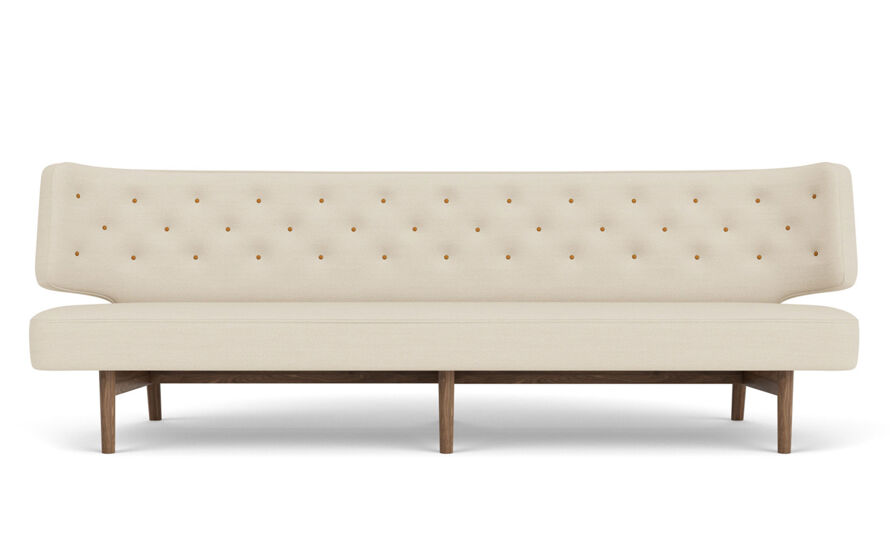Radiohus P3 Sofa
by Vilhelm Lauritzen from Audo
radiohus p3 sofa
Design Vilhelm Lauritzen, 1936
Solid oak or walnut, upholstery
Made by Audo
An exclusive and rare design from Vilhelm Lauritzen, the Radiohus Sofa was designed for Denmark's Radio House (today the Royal Danish Academy of Music) in 1936. A pioneering piece of Nordic Functionalism, the elegant design shunned the conservative and straight lines of the time in favor of a more futuristic expression. Beautiful from all angles, its elegant wooden frame holds a beautifully upholstered seat and back that are shaped to embrace the sitter, while the quilted back highlights the exactness of its design. A piece of furniture that requires space, let it stand freely in a room.
Vilhelm Theodor Lauritzen (1894-1984) was a Danish architect who became a symbol of modern life in the 1930s. He is noted for some of Copenhagen's most iconic buildings including Radiohus, Folkets Hus (now Vega) and the now defunct Terminal 2 at Copenhagen Airport, all of which are today listed. Radiohus, designed to headquarter the national broadcaster, DR, and today the Royal Danish Music Conservatory, stands as a proud symbol of Danish functionalism and modernism. Radiohus was a gesamtkunstwerk. Vilhelm Lauritzen designed everything from door handles, railings and ashtrays to lamps, sofas and counters, in close collaboration with Finn Juhl, who was employed under Lauritzen from 1934 to 1945.
The Radiohus sofa was designed in 1936 for the foyer of the building. Profiling a new, soft Nordic functionalism, the sofa is a fusion of the two designers' sensibilities: Juhl's organic and sculptural idiom and Lauritzen's stringent functionalism.
The Radiohus Sofa is available in either a natural oak or walnut frame and the buttons can either be matched to the chosen upholstery or contrasted in a cognac leather.
101.5" w | 30.3" d | 33.8" h | seat: 17.7" h
Solid oak or walnut, upholstery
Made by Audo
An exclusive and rare design from Vilhelm Lauritzen, the Radiohus Sofa was designed for Denmark's Radio House (today the Royal Danish Academy of Music) in 1936. A pioneering piece of Nordic Functionalism, the elegant design shunned the conservative and straight lines of the time in favor of a more futuristic expression. Beautiful from all angles, its elegant wooden frame holds a beautifully upholstered seat and back that are shaped to embrace the sitter, while the quilted back highlights the exactness of its design. A piece of furniture that requires space, let it stand freely in a room.
Vilhelm Theodor Lauritzen (1894-1984) was a Danish architect who became a symbol of modern life in the 1930s. He is noted for some of Copenhagen's most iconic buildings including Radiohus, Folkets Hus (now Vega) and the now defunct Terminal 2 at Copenhagen Airport, all of which are today listed. Radiohus, designed to headquarter the national broadcaster, DR, and today the Royal Danish Music Conservatory, stands as a proud symbol of Danish functionalism and modernism. Radiohus was a gesamtkunstwerk. Vilhelm Lauritzen designed everything from door handles, railings and ashtrays to lamps, sofas and counters, in close collaboration with Finn Juhl, who was employed under Lauritzen from 1934 to 1945.
The Radiohus sofa was designed in 1936 for the foyer of the building. Profiling a new, soft Nordic functionalism, the sofa is a fusion of the two designers' sensibilities: Juhl's organic and sculptural idiom and Lauritzen's stringent functionalism.
The Radiohus Sofa is available in either a natural oak or walnut frame and the buttons can either be matched to the chosen upholstery or contrasted in a cognac leather.
101.5" w | 30.3" d | 33.8" h | seat: 17.7" h
Vilhelm Lauritzen
Vilhelm Theodor Lauritzen (1894-1984) was one of Denmark's most important architects of his time and helped pave the way for Danish Modernism. Classic work includes designs for radiohus.
Developed by uniting Menu, Audo & by Lassen. Audo Copenhagen reflects a century of Danish design tradition with a modern global outlook that continually evolves. Shaped by purposeful details, quality materials and human needs.

















 write a review now
write a review now
